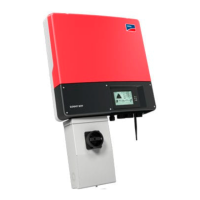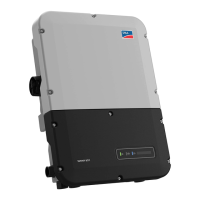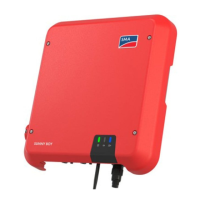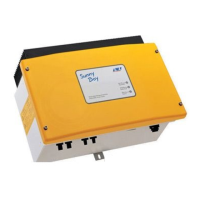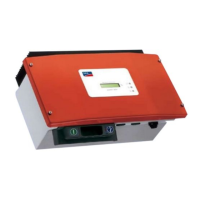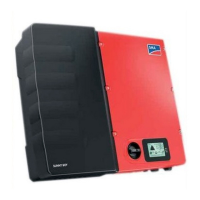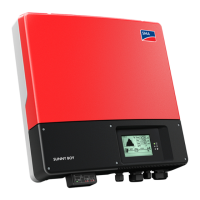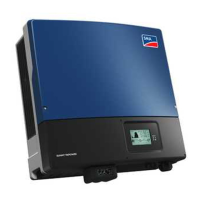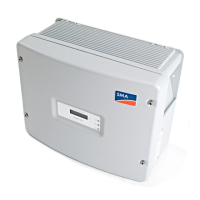Do you have a question about the SMA SUNNY BOY 7000-US and is the answer not in the manual?
Explains different warning levels like DANGER, WARNING, CAUTION, NOTICE used in the manual.
Describes the 'Information' symbol used in the guide for supplementary details.
Explains symbols used on the product itself, like danger voltage, hot surface, and operating instructions.
Specifies the SMA inverters covered and defines the manual's intended audience as qualified personnel.
Provides guidance on storing documentation and defines the term 'SMA' used in the document.
Explains the Sunny Boy's function and covers general safety precautions and intended use.
Details critical safety instructions, including DANGER and CAUTION warnings regarding high voltages and weight.
Provides a brief summary of the entire installation process for the Sunny Boy inverter.
Guides users on checking the delivery and lists all components included in the Sunny Boy package.
Details the process of opening the Sunny Boy inverter and important precautions for handling its components.
Identifies and describes the various internal components and connection terminals within the Sunny Boy.
Explains how to configure the inverter for different grid voltages and details connection steps.
Describes how to set jumpers for different grid topologies and fan test configurations.
Highlights dangers like fire/explosions and physical injury during assembly due to weight.
Specifies location requirements, orientation, and necessary clearances around the inverter for safety and performance.
Details installation of the wall bracket, DC disconnect, and the Sunny Boy inverter onto the wall.
Covers critical electrical connection safety warnings, installation standards, and grounding requirements.
Details AC connection requirements, wiring in the DC disconnect, and connecting cables to the Sunny Boy.
Covers DC connection requirements, grounding, and connecting cables in the DC disconnect and Sunny Boy.
Provides instructions for securely closing the Sunny Boy and DC disconnect units after wiring.
Outlines steps for powering up the inverter, including breaker activation and AFCI self-test.
Addresses scenarios where the Sunny Boy fails to resume operation, including voltage checks and contacting SMA.
Explains how to address AFCI disturbance messages, including troubleshooting and restarting.
Describes actions for EarthCurrentMax messages, indicating ground faults, and restarting after rectification.
Explains the meaning of LED status indicators (green, red, yellow) and their operational states.
Describes LED indicators for standby, initialization, and ground faults.
Explains LED indications for 'Start' and 'Waiting' modes of the inverter.
Details LED indications for standard operation modes and derating due to high temperatures.
Explains fault indicators like 'Ground Fault' and 'Cleared GFDI Fuse', including troubleshooting.
Describes LED indications for control system faults and grid failures, including causes and actions.
Details LED indications for high DC input voltage and internal interference, requiring technician intervention.
Explains LCD backlight activation and lists initial and operational messages.
Describes how the LCD displays fault types like Interference, Warning, and Error.
Guides on changing the LCD display language using slide switches.
Introduces measuring channels and parameters, defining abbreviations.
Lists and defines various measurement channels and parameters for monitoring.
Describes different operating modes like Stop, MPP, V-Const, and Turbine.
Details parameters that can be adjusted, including AFCI and anti-island settings.
Lists fixed parameters like Vpv-Start, Plimit, and firmware versions.
Outlines general procedures for diagnosing and resolving inverter faults.
Lists and explains various error types, codes, and their descriptions for troubleshooting.
Details cleaning the inverter fans, including fan guard removal and fan unit cleaning.
Explains cleaning handle covers for heat dissipation and insect protection.
Recommends checking the DC disconnect regularly and activating it annually.
Describes methods for testing fan operation via installer mode or jumper.
Details the procedure for safely exchanging the GFDI fuse inside the Sunny Boy.
Provides instructions for replacing PV string fuses within the DC disconnect.
Guides on testing and replacing DC varistors, especially for overvoltage protection.
Lists technical specs for 5000-US, 6000-US, 7000-US, and 8000-US models, including PV, grid, and environmental data.
Shows efficiency curves, ambient temperature ranges, and mechanical data for the inverter models.
Details trip limits, torque values, cable sizes, spare parts, and accessories.
Outlines FCC rules the device complies with, including operational conditions.
| Model | SUNNY BOY 7000-US |
|---|---|
| Type | String Inverter |
| Maximum DC Power | 7000 W |
| AC Nominal Power | 7000 W |
| Max. AC Apparent Power | 7000 VA |
| Max. Input Voltage | 600 V |
| Nominal AC Voltage | 240 V |
| Max. Output Current | 29.2 A |
| Efficiency | 97.5 % |
| Number of MPP Trackers | 2 |
| Topology | Transformerless |
| Cooling | Convection |
| AC Frequency | 60 Hz |
| MPP Voltage Range | 200-500 V |
| MPPT Range | 200-500 V |
| AC Voltage Range | 211 V - 264 V |
| Communication | Ethernet |
| Operating Temperature Range | -13 °F to 140 °F |
